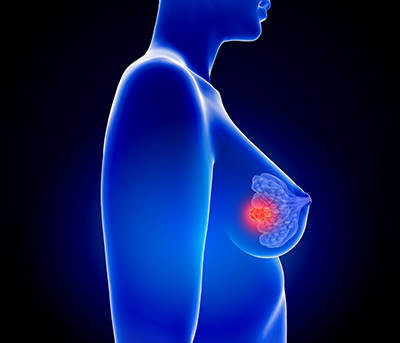
What it is?
Breast cancer occurs when abnormal breast cells grow uncontrollably, potentially forming tumors and spreading. It is the most common cancer in women worldwide but can also affect men, though rarely. Breast cancer is now recognized as four distinct diseases, classified by the presence or absence of hormone receptors (HR) and HER2: HR+/HER2−, HR+/HER2+, HR−/HER2+, and triple-negative.
Breast cancers are classified based on where they start and how they behave. Understanding the type of breast cancer is important because it helps guide the most effective treatment.
Main types include:
- Ductal carcinoma in situ (DCIS): Early-stage, non-invasive cancer in the milk ducts.
- Invasive ductal carcinoma (IDC): The most common type (70–80%). Begins in ducts and invades nearby tissue.
- Invasive lobular carcinoma (ILC): Starts in the lobules and spreads to surrounding tissue.
- Triple-negative breast cancer (TNBC): Does not have estrogen, progesterone, or HER2 receptors—more aggressive and harder to treat.
- HER2-positive breast cancer: Overproduces HER2 protein, causing rapid growth.
- Inflammatory breast cancer: A rare but aggressive form that causes redness and swelling.
- Male breast cancer: Rare, but similar in biology and treatment.
Main symptoms
- A lump in the breast or armpit
- Changes in breast shape or size
- Skin dimpling or thickening
- Nipple inversion or unusual discharge
- Redness, rash, or pain in the breast
Standard treatments:
- Surgery is usually the first treatment. It can be a lumpectomy, removal of the tumor only; or a mastectomy, removal of the whole breast
- Radiation therapy uses high-energy rays to kill cancer cells; often follows surgery to destroy remaining cancer cells.
- Chemotherapy it is often used before or after surgery to treat or prevent metastasis.
- Hormone therapy is used for hormone (estrogen and/or progesterone) receptor-positive cancers. The hormone therapy acts by blocking the natural hormones from reaching the cancer cells or by stopping the body from producing them.
- Targeted therapy uses special drugs that attack specific parts of cancer cells, responsible for the cancer growth or survival; sparing most healthy cells. It is mainly used for HER2-positive cancers.
Radiotheranostics
Radiotheranostics is a new type of treatment that combines therapy and diagnostics. Currently there are no approved radiotheranostics for breast cancer.
Many companies are conducting clinical trials as shown below.
Your doctor can help you understand which treatment is right for you
To know more about:
Patient associations
Europe: 10 Femmes pour un 4000 (BEL), Action for Breast Cancer Foundation (MLT), Au sein des femmes (BEL), BIG (Breast International Group) (BEL), Bortskanker Vlaanderen vzw (BEL), Breast Cancer Now (GBR) Europa Donna (EU), Lovely Solidarity (BEL), Pink Ribbon (BEL), Think Pink (BEL), Vivre comme Avant (BEL)
Worldwide: Breastcancer.org, Metastatic Breast Cancer Network (MBCN)
North America: After Breast Cancer Diagnosis (ABCD) (USA), Breast Cancer Alliance, Breast Cancer Research Foundation (BCRF) (USA), Breast Friends (USA), Faithful Warriors (USA), Pink Divas and Gents (USA), Sisters Network (USA), Young Survival Coalition (USA)
